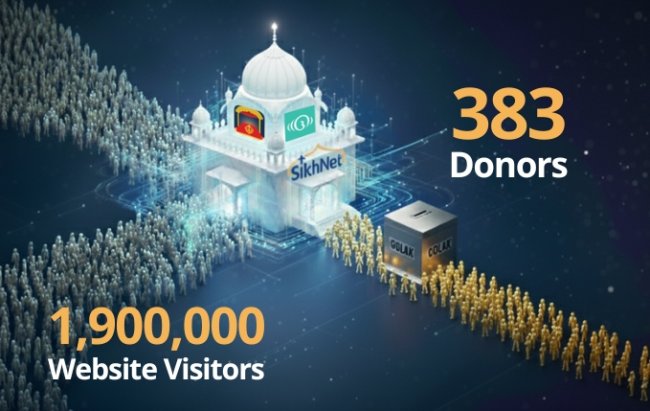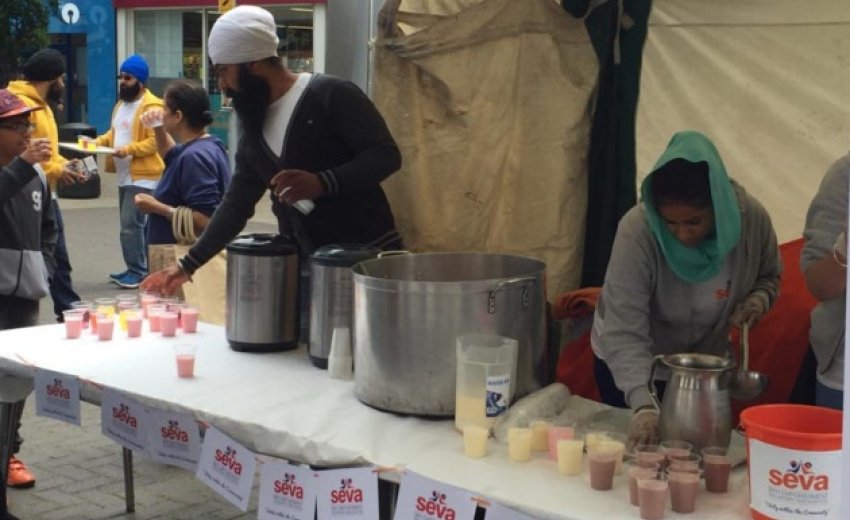Dastar, the Punjab word for turban, is a point of pride for every Sikh who decides to wear one. While many outside the Sikh community see one every day, not everyone understands the symbolic importance of the turban.
Like the tie in western society, the turban conveys dignity and respect, and its significance ranges from the formal act of gift-giving to the intimate ritual of tying one. Unlike the tie, the turban has a history dating back thousands of years, but it, too, serves a practical purpose.
Since a Khalsa Sikh (one who is ready to become orthodox) grows out his hair and beard, he wears a turban to keep the hair clean and orderly, and to remind the wearer of a central tenet of Sikhism.
Because turbans were traditionally only worn by the upper classes in India’s caste system, Guru Nanak, the founder of the Sikh faith, encouraged all his followers to wear turbans to eliminate this oppressive system. It is a constant reminder that every man is free.
Likewise, because Indians’ last names reflected their caste, all Sikhs were encouraged to have the same last name — Singh, which means lion, or Kaur, which means lioness.
The Sikh faith is at its very core a democratic and decentralized religion, but the Sikh community in Queens has recently begun to mobilize as political force. As Sikhs set down roots in Queens, several activists have been organizing their community to advocate for its unique needs. They are attempting to find common allies in their demands for better schools, public safety and a direct line of communication with the government.
“It is very much a decentralized community, the heart of which is the gurdwara,” said Gurpal Singh, the founder of SEVA, a Queens-based volunteer advocacy group. The gurdwara, known as “the doorway to God,” serves as both a temple and a community center.
On Sundays the gurdwara is packed with men and women in one room bowing before the Guru Granth Sahib, while the jatha (musicians) sing and play their instruments. In another room, people are seated in rows on the floor, talking and eating the langar, which is the communal meal provided for visitors. The kitchen is bustling with a dozen or so volunteers cooking and serving the food as fast as it comes off the stove.
Everyone is welcome inside the gurdwara, provided they remove their shoes and cover their hair.
There are children running to and fro all around the gurdwara. They are the new generation at the heart of their community’s concerns. While Sikhs have been in Queens for many decades, their numbers swelled after the Indian government crackdown that followed the assassination of Prime Minister Indira Gandhi.
She was killed by two of her Sikh bodyguards after she ordered the army to storm the holiest Sikh temple in 1984. The event sparked violent reprisals that spurred many Sikhs to seek political asylum in the U.S. Like so many immigrants to New York, they came to flee violence and to set up better lives. As the Sikh community matures and grows, it has come to see Queens as its new home.
According to estimates based on the 2000 Census, there are 70,000 Sikhs in Queens, but Gurpal Singh says that figure is low. “The census undercounts the Sikh community by at least a few percentage points for a variety of reasons, some as simple as people being afraid to open their doors,” he said. “But it is certainly something we are gearing up to address for the 2010 census.”
Mohinder Singh, the founder and president of the Baba Makhan Shah Lobana Sikh Center, located at 111-01 101st Ave. in Richmond Hill, agrees with the importance of an accurate gauge of the population. “Democracy is a game of numbers,” he said. “We invite politicians into the gurdwara and show them — look, there are a thousand prospective voters here right now.”
Sikhs tend to work in construction, run their own businesses, drive cabs, work as brokers or own gas stations, according to Mohinder Singh. They are independent, both in opinions and in finance, and the community strives to look after its own.
“The family structure helps to insulate from economic trouble, and there is always someone who will help,” he said. “Every Singh must be a saint soldier and help his fellow man.”
While there is no consensus on a common candidate for the February special election in the 32nd Council District to fill City Councilman and Senator-elect Joseph Addabbo Jr.’s seat, there is agreement about which issues the Sikh community wants addressed.
“First always is the education,” Gurpal Singh said. “The next generation is the most important thing.” Specific efforts to save and expand after-school programs and other scholastic opportunities are a top priority for Sikhs. They also want a more “culturally relevant” curriculum that would address immigrant traditions and attire in order to foster respect and curiosity among students.
Intolerance in schools was a severe problem for the Sikh community during the 2007-2008 school year. A number of students were harassed and assaulted because of their turbans and long hair. In June, the Sikh community staged a protest outside Richmond Hill High School, where one Sikh teen was punched in the face by a classmate.
Safety outside the schools is a grave concern, as well: there is always a sense of anxiety in the community about hate crimes. “We want to know if we are in the plan,” said Mohinder Singh, referring to the plan of action the city has developed as a response to another potential terrorist attack.
After the attacks of Sept. 11, many Sikhs were taunted and became targets for angry Americans who blamed them for the tragedy, mistaking them for Muslims. Sikh leaders want assurance that such a thing will never happen again. “There must be a way to defend innocent people from ignorant retaliation,” Mohinder Singh said.
According to Gurpal Singh, this is an issue that must be urgently addressed. “There’s no plan — before you ask about the plan, ask if there is any dialogue.”
Some of the candidates running for Addabbo’s council seat said they, too, believe communication with the Sikh community is key. Rockaway Democratic District Leader Lew Simon promised town hall meetings to bring neighbors together. Ozone Park Republican District Leader Eric Ulrich emphasized his commitment to what he called social justice, which includes speaking out against hate crimes and workplace discrimination. Democratic District Leader Frank Gulluscio of Howard Beach emphasized “open lines of communication.”
But the Sikh community is not waiting for politicians to act on its behalf. Groups like SEVA have been laying the groundwork for community involvement. They encouraged Sikhs to register and vote in this year’s elections, and are working to help the community itemize its demands and publicize them. “Once we get bodies in the room they feel empowered and there is a rush of possibilities,” Gurpal Singh said.
Much of this activism is focused on finding allies and reaching out to them. The Sikhs have partnered with the West Indian community several times, most recently in late October. The two groups put together the last debate between state Sen. Serphin Maltese (R-Glendale) and his challenger, Addabbo.
It was the first public event held by the South Asian/West Indian Council. The word SAWI itself was coined on Aug. 8, when Gurpal Singh was struggling for a convenient way to refer to the community leaders who had assembled for their first meeting to discuss common interests.
The coalition goes deeper than a catchy acronym. “It may seem like these two groups have nothing in common, but actually they have almost everything in common,” Gurpal Singh said. “If there is a Sikh who lives on a block, there is almost definitely a West Indian living there too. They have the same concerns and they both feel marginalized.”
At their first meeting, the leaders immediately discovered they were experiencing similar problems, including what they see as slow police response times, harassment in schools, insufficient public education and confusion about how to acquire city services. “It was a natural fit,” Gurpal Singh said.
The two groups also share a common heritage, although it split hundreds of years ago. The West Indian immigrant population from Guyana, Trinidad and Suriname is descended from Indian indentured servants who were brought to the new world to work in plantations.
The word SAWI has already begun to appear on posters and flyers. “People get a lot of joy saying it,” Gurpal Singh said. “I think after eight or 10 events, it’ll trickle down to the fifth grade lunch table.”
Sikh and West Indian leaders are confident that they are making headway. The SAWI debate succeeded in drawing media coverage and a new awareness of the two communities, particularly from politicians who view them as a voting bloc. SAWI is already contemplating organizing a mayoral debate.
Meanwhile, SEVA will continue the “bread and butter” work of helping its communities acquire the city, state and federal services available, but not always accessible, to them. The group is also expanding its efforts to give the South Asian community an active voice in federal immigration reform. “We must participate in the large trends that are happening in this country, so we can be a part of the change,” Gurpal Singh said.
The Sikh religion has no problem finding a home in the diversity of Queens. It does not proselytize its faith, but instead opens its doors to those from other faiths. The religion was founded on egalitarian notions of a classless society with women’s rights and real-world action.
“The gurus taught you must go into the world, you must have a home and not hide,” according to Gurpal Singh. “But of course not everyone lives up to all these ideals.” He is particularly concerned with the male dominance of the SAWI community and has been organizing a SAWI women’s group within SEVA, “because right now, we are only hearing half the concerns.”
There is another challenge immigrant organizers must overcome — a “transient mentality” that keeps Sikhs from getting involved in local politics. Like many immigrants, they come to Queens to make money and to find a foothold, but many assume they will return to Punjab in India, or move to the suburbs.
The Sikhs in the gurdwaras seem involved in their social circle, socializing, eating traditional foods, caring for their children and donating money to expand their community centers — all the trappings of a new homeland.

